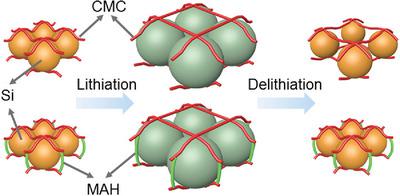当前位置:
X-MOL 学术
›
Macromol. Chem. Phys.
›
论文详情
Our official English website, www.x-mol.net, welcomes your
feedback! (Note: you will need to create a separate account there.)
3D Network Binder via In Situ Cross‐Linking on Silicon Anodes with Improved Stability for Lithium‐Ion Batteries
Macromolecular Chemistry and Physics ( IF 2.5 ) Pub Date : 2019-12-05 , DOI: 10.1002/macp.201900414 Pengcheng Li 1 , Gen Chen 1 , Yifan Lin 1 , Fashen Chen 1 , Long Chen 1 , Ning Zhang 1 , Yijun Cao 2 , Renzhi Ma 3 , Xiaohe Liu 1
Macromolecular Chemistry and Physics ( IF 2.5 ) Pub Date : 2019-12-05 , DOI: 10.1002/macp.201900414 Pengcheng Li 1 , Gen Chen 1 , Yifan Lin 1 , Fashen Chen 1 , Long Chen 1 , Ning Zhang 1 , Yijun Cao 2 , Renzhi Ma 3 , Xiaohe Liu 1
Affiliation

|
Silicon (Si) has attracted intensive academic and commercial attention due to its extremely high theoretical capacity. However, it is still far away from practical application because of its fast capacity fading, which is caused by the huge volume change. Here, a novel network polymer binder is synthesized through in situ thermal crosslinking of water‐soluble carboxymethyl cellulose (CMC) and maleic anhydride (MAH). The as‐obtained polymer binder network can effectively restrict the huge volume change of Si anodes upon lithiation. Because of the significantly enhanced structural stability, the Si anodes with network polymer binder deliver enhanced electrochemical performance, with a capacity of 996 mAh g−1 at a high current density of 1 A g−1 after 120 cycles under high mass loading. Most importantly, a high average Coulomb efficiency (CE) of 99.4% is obtained, which is superior over the average CE (98.7%) of Si only using CMC as binder. It is considered that this novel 3D network cross‐linking binder can be used for high‐capacity anode materials in next‐generation Li‐ion batteries.
中文翻译:

通过硅阳极上原位交联的3D网络粘合剂,提高了锂离子电池的稳定性
硅(Si)由于其极高的理论能力而引起了学术界和商业界的广泛关注。但是,由于容量的巨大变化,容量衰减很快,因此离实际应用还很遥远。在这里,一种新型的网络聚合物粘合剂是通过水溶性羧甲基纤维素(CMC)和马来酸酐(MAH)的原位热交联合成的。如此获得的聚合物粘合剂网络可以有效地限制锂化时硅阳极的巨大体积变化。因为显著增强的结构稳定性的,在Si与阳极网状聚合物粘结剂提供增强的电化学性能,以996毫安g的容量-1在1A g的高电流密度-1在高负载下120次循环后。最重要的是,获得了99.4%的高平均库仑效率(CE),这优于仅使用CMC作为粘合剂的Si的平均CE(98.7%)。人们认为,这种新颖的3D网络交联粘合剂可用于下一代锂离子电池中的高容量阳极材料。
更新日期:2019-12-05
中文翻译:

通过硅阳极上原位交联的3D网络粘合剂,提高了锂离子电池的稳定性
硅(Si)由于其极高的理论能力而引起了学术界和商业界的广泛关注。但是,由于容量的巨大变化,容量衰减很快,因此离实际应用还很遥远。在这里,一种新型的网络聚合物粘合剂是通过水溶性羧甲基纤维素(CMC)和马来酸酐(MAH)的原位热交联合成的。如此获得的聚合物粘合剂网络可以有效地限制锂化时硅阳极的巨大体积变化。因为显著增强的结构稳定性的,在Si与阳极网状聚合物粘结剂提供增强的电化学性能,以996毫安g的容量-1在1A g的高电流密度-1在高负载下120次循环后。最重要的是,获得了99.4%的高平均库仑效率(CE),这优于仅使用CMC作为粘合剂的Si的平均CE(98.7%)。人们认为,这种新颖的3D网络交联粘合剂可用于下一代锂离子电池中的高容量阳极材料。











































 京公网安备 11010802027423号
京公网安备 11010802027423号